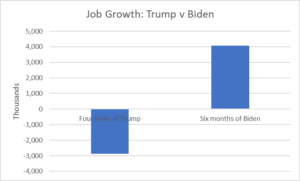Article • Dean Baker’s Beat the Press
Cheap Fun Saturday: Job Growth Under Biden and Trump

Article • Dean Baker’s Beat the Press
Fact-based, data-driven research and analysis to advance democratic debate on vital issues shaping people’s lives.
Center for Economic and Policy Research
1611 Connecticut Ave. NW
Suite 400
Washington, DC 20009
Tel: 202-293-5380
Fax: 202-588-1356
https://cepr.net
Another jobs report, another cheap shot at the former guy. As I always say, this sort of comparison is silly because so many things beyond the president’s control affect job growth and the economy. But, you know that if the situation were reversed, we would be hearing this comparison endlessly. Donald Trump Jr. would probably even have the graph tattooed on his forehead.
So, here’s where we stand now. After yesterday’s big jobs number, Biden has now created 4.1 million jobs in the first six months of his presidency. Trump lost 2.9 million jobs over his four years in office.

Source: Bureau of Labor Statistics.